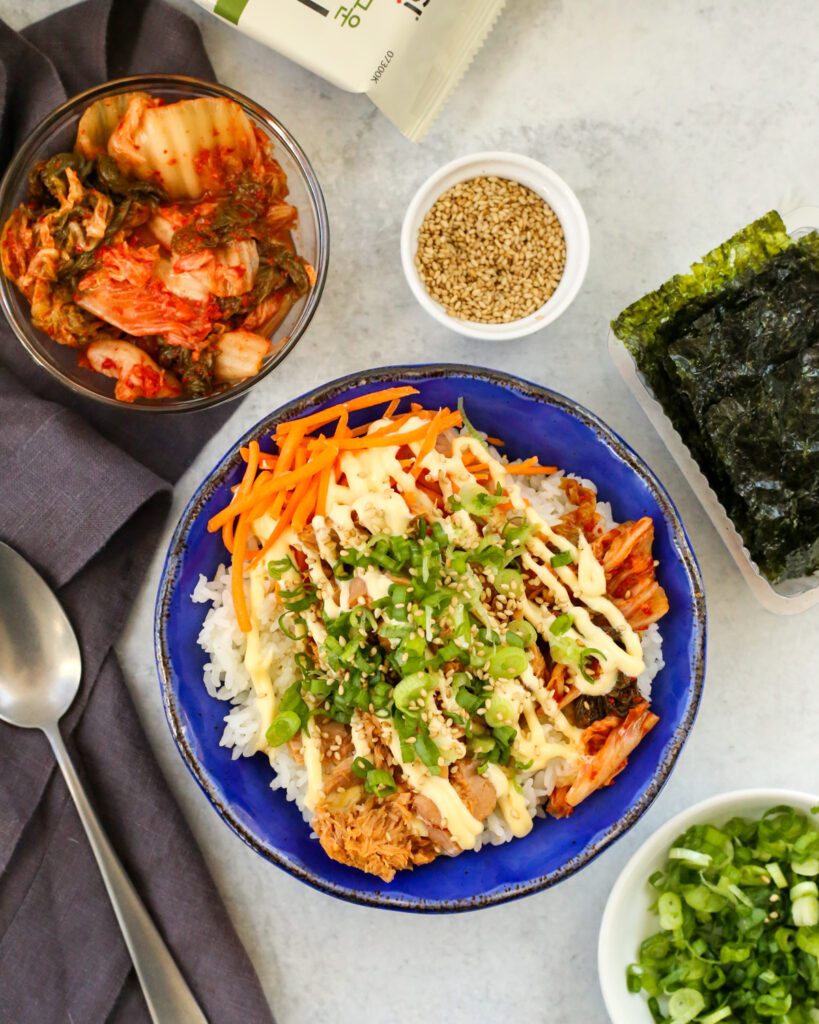Korean Chicken Rice Bowls a Flavor Packed Comfort Food is a delicious recipe that combines amazing flavors and textures.
Korean Chicken Rice Bowls represent the perfect harmony of flavor, texture, and nutrition, bringing together the bold tastes of Korean cuisine in an accessible format that satisfies both the palate and the soul. This dish features gochujang-marinated chicken, fluffy rice, quick-pickled vegetables, and a perfectly cooked egg, creating a complete meal that balances spicy, sweet, salty, and umami flavors in every bite. The contrast between the caramelized chicken, crisp vegetables, creamy egg yolk, and chewy rice creates a textural experience that keeps each mouthful interesting.
What makes this dish exceptional is its versatility and adaptability. While rooted in Korean culinary traditions, the rice bowl format appeals to global tastes and can be customized based on preferences and available ingredients. The gochujang marinade provides the signature Korean flavor profile—spicy, sweet, and deeply savory—while the fresh and pickled vegetables add brightness and crunch that cut through the richness. The egg adds protein and luxurious texture, making the dish feel complete and satisfying. This recipe offers restaurant-quality results with home kitchen techniques, making it perfect for weeknight dinners and entertaining alike.
The Evolution of Korean Rice Bowls
Rice bowls have been a staple of Korean cuisine for centuries, with variations found across different regions and seasons. The modern concept of elaborate rice bowls (often called “bibimbap” meaning mixed rice) gained international popularity during the Korean Wave of the 2000s, as Korean culture spread globally through music, television, and film. These bowls represent the Korean culinary philosophy of balancing flavors, textures, and colors in a single dish.
This particular version with gochujang-marinated chicken reflects the globalization of Korean flavors and their adaptation to Western preferences. Gochujang, the fermented chili paste that forms the base of the marinade, has become increasingly available in international markets, allowing home cooks to recreate authentic Korean flavors. The rice bowl format appeals to contemporary eating habits that value both convenience and culinary adventure, making it a perfect introduction to Korean cuisine for those unfamiliar with its traditions.
Ingredient Selection Guide
Gochujang Quality: Use authentic Korean gochujang for the best flavor. It should have a deep red color and complex fermented flavor. The consistency should be thick and paste-like. Store opened gochujang in the refrigerator where it will keep for months.
Rice Variety: Short-grain Korean or Japanese rice provides the ideal sticky texture that holds together well in bowls. Brown rice can be substituted for added nutrition, though the texture will be different. Cook rice with slightly less water for firmer grains that stand up to the other components.
Chicken Selection: Boneless chicken thighs work best for their flavor and tenderness. Breast meat can be used but may dry out more easily. slice against the grain for the most tender results. Skin-on thighs can be used for extra crispiness if pan-seared properly.
Vegetable Freshness: Use the freshest, crispest vegetables for the best textural contrast. Julienne vegetables uniformly for even eating. Seasonal variations can include spinach, bean sprouts, mushrooms, or whatever is available and fresh.
The Science of Korean Flavors
Korean cuisine is built on the foundation of fermented ingredients that develop complex umami flavors. Gochujang is made from fermented soybeans, rice, and chili peppers, creating a depth of flavor that cannot be replicated with simple chili paste. The fermentation process breaks down proteins and starches into amino acids and simple sugars, creating naturally occurring MSG-like compounds that enhance savoriness.
The balance of flavors in Korean cooking follows a specific philosophy: sweet, salty, spicy, sour, and bitter should all be present in harmony. This dish achieves this through the sweet brown sugar and honey, salty soy sauce, spicy gochujang, sour rice vinegar, and slight bitterness from the sesame oil. Understanding this balance allows for adjustments based on personal preference while maintaining the essential character of the dish.
Step-by-Step Technique Mastery
Marinating Time: The chicken benefits from at least 30 minutes of marinating, but no more than 4 hours as the acidity can begin to break down the proteins. Bring to room temperature for 15 minutes before cooking for more even cooking.
Cooking Temperature: Use high heat to achieve proper caramelization on the chicken without overcooking. Do not overcrowd the pan, which causes steaming rather than searing. Work in batches if necessary to maintain pan temperature.
Rice Preparation: Rice should be rinsed until water runs clear to remove excess starch. Let cooked rice rest for 10 minutes before fluffing with a fork. Season rice with a pinch of salt and teaspoon of sesame oil for extra flavor.
Egg Preparation: Soft-boiled eggs should be started in cold water, brought to a boil, then cooked for 6-7 minutes for runny yolks. Immediately transfer to ice water to stop cooking. For fried eggs, use medium heat and cover briefly to set whites while keeping yolks runny.
Flavor Development Secrets
Enhance the marinade by adding a tablespoon of grated Asian pear or apple, which contains enzymes that tenderize the meat naturally. A teaspoon of fish sauce adds depth without making the dish taste fishy.
Toast the sesame seeds before using to enhance their nutty flavor. For extra aroma, toast the sesame oil very briefly before adding to the marinade—be careful as it can burn easily.
Add a teaspoon of doenjang (Korean fermented soybean paste) to the marinade for extra umami complexity. For smokiness, add a drop of liquid smoke or use smoked gochujang if available.
Professional Presentation Techniques
Arrange components separately in the bowl for visual appeal. The traditional circular arrangement of different colored vegetables creates a visually striking presentation. Place the egg in the center as a focal point.
Serve with additional gochujang sauce on the side for diners to adjust spice level. Provide small dishes of extra toppings like kimchi, roasted seaweed, or crushed nuts for customization.
Use stone bowls (dolsot) for authentic bibimbap experience—the bowl retains heat and creates crispy rice at the bottom. Warm serving bowls before assembling to keep the food hot longer.
Nutritional Considerations
This dish provides balanced nutrition with protein from chicken and eggs, carbohydrates from rice, and vitamins from vegetables. Gochujang contains capsaicin which may boost metabolism, and fermented foods support gut health.
For a lighter version, use brown rice or cauliflower rice, increase vegetable portions, and use chicken breast instead of thighs. Reduce sugar in the marinade or use sugar substitutes.
For gluten-free, use tamari instead of soy sauce and ensure gochujang is gluten-free (some brands contain wheat). For vegetarian, substitute tofu or tempeh for chicken and use vegetarian fish sauce alternative.
Storage and Freshness Preservation
Components can be prepared ahead and stored separately. Marinated chicken can be refrigerated for up to 24 hours. Pickled vegetables keep for up to 2 weeks refrigerated. Cooked rice can be refrigerated for 3-4 days.
Assembled bowls are best eaten immediately, but components can be reheated separately. The chicken reheats well in a skillet or microwave. The egg is best cooked fresh.
Freeze marinated chicken for up to 3 months. Thaw in refrigerator before cooking. The texture may be slightly softer after freezing but still delicious.
Cultural Significance and Modern Adaptations
Korean Chicken Rice Bowls represent the globalization of Asian flavors and their adaptation to Western eating habits. They reflect the growing appreciation for bold, complex flavors and the popularity of bowl foods that offer complete meals in a single vessel.
Contemporary variations include different proteins (beef, pork, fish), grain alternatives (quinoa, farro, noodles), and fusion elements (Mexican-Korean, Hawaiian-Korean). These adaptations demonstrate the versatility of the basic formula while maintaining the essential balance of flavors and textures.
Final Thoughts
Korean Chicken Rice Bowls offer a complete culinary experience that satisfies on multiple levels—flavor, texture, nutrition, and visual appeal. Their adaptability makes them perfect for customizing based on preferences and available ingredients. As you experience the harmony of spicy, sweet, salty, and umami flavors, appreciate how this dish represents both tradition and innovation in Korean cuisine. May this recipe become a cherished part of your cooking repertoire, bringing excitement and comfort to your table.

Korean Chicken Rice Bowls a Flavor Packed Comfort Food
Ingredients
Method
- Combine all marinade ingredients in a bowl
- Add sliced chicken and toss to coat
- Marinate for at least 30 minutes, or up to 4 hours
- Cook rice according to package instructions
- Make quick pickles by combining vinegar, water, sugar, and salt
- Pour over julienned vegetables and let sit for 20 minutes
- Prepare gochujang sauce by whisking all ingredients
- Soft-boil or fry eggs to desired doneness
- Heat a large skillet or wok over high heat
- Add marinated chicken in a single layer
- Cook for 5-7 minutes without moving to develop sear
- Stir-fry until cooked through and caramelized
- Remove from heat and let rest
- Divide rice among serving bowls
- Top with cooked chicken, pickled vegetables, and fresh vegetables
- Add an egg to each bowl
- Drizzle with gochujang sauce
- Garnish with green onions, sesame seeds, and nori



